This review crosses out a number of firsts.
For starters, this will be the first product review I’ve done for SFFn (as well as my last, somewhat ironically, now that I’ve taken on my new role with Minutiae). It will also be the first pre-built desktop that SFF Network has ever reviewed, given our history up to this point of only ever reviewing components and the like. But when we first caught wind of the opportunity to review the Nightblade MI3, perhaps the ‘first’ that was at the forefront of my mind was this: would this be the first pre-built computer that I could actually recommend?
After weeks of use, and additional weeks of consideration, I have my answer. But as is true for all reviews, the joy is in the journey. So let’s retrace my steps.
Some background on the Nightblade, and on MSI’s pre-builts
The Nightblade occupies an interesting segment of an even more interesting lineup of pre-builts sold by MSI. MSI is quite unusual in the desktop marketplace insofar that they’re a company that actually makes most of the components that it then assembles into the ready-to-ship PCs it sells. Furthermore, whereas most pre-builts focus on modularity and flexibility, MSI have leveraged their position as a manufacturer to turn around the sorts of unique and – importantly to us, compact – designs that distinguish them strongly from the rest.
Perhaps nothing illustrates this best than a screenshot of the flagship line of desktops on MSI’s own website. Aside from the Aegis Ti3, each one of those machines falls well within the definition of SFF that we use both editorially, as well as for SFF Forum – 19L or less. That’s pretty impressive given that this lineup is meant to cover the gamut of configurations and segments that MSI addresses in the pre-built market. SFF may be a niche to some manufacturers, but for MSI it has quickly become the norm.
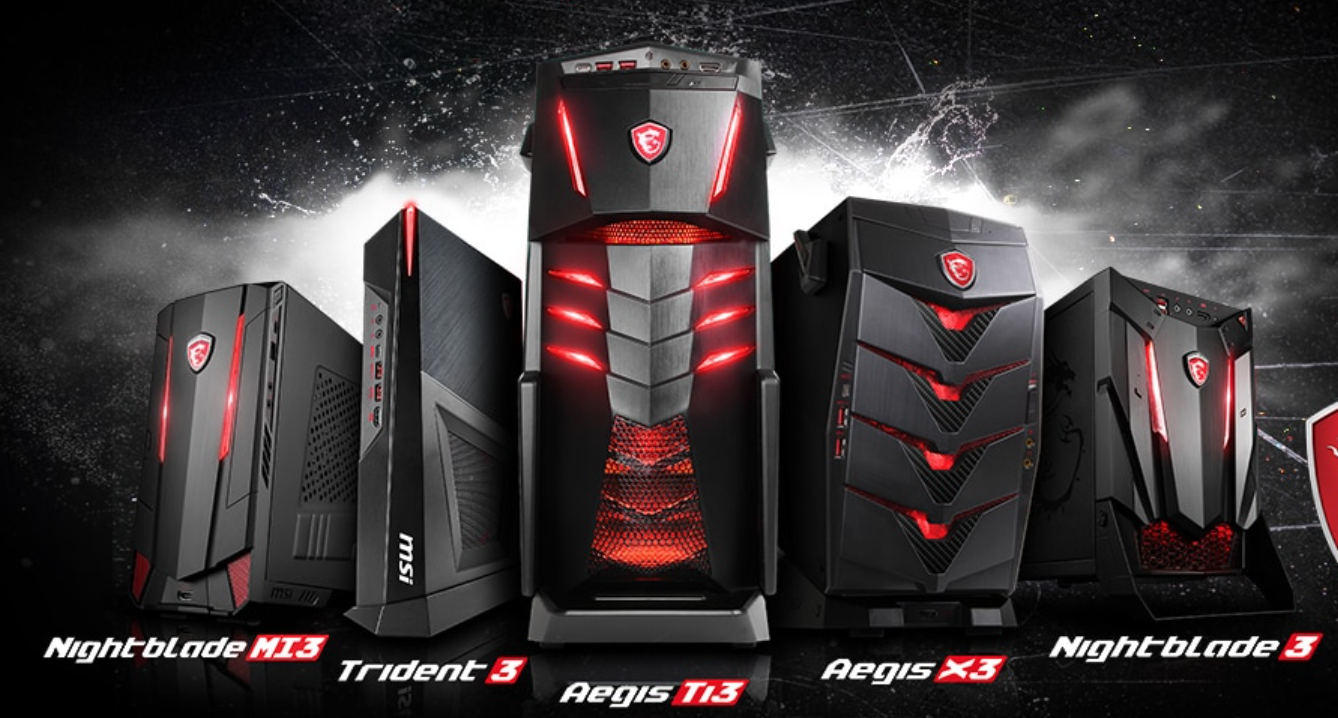
But let’s consider the Nightblade specifically. The MI3 is a refinement on the previous generation of the machine, which was fundamentally the same product, if not with older parts and a few aesthetic distinctions. With small form factor builds, the proportions tend to matter more since consumers will be sensitive to footprint size and orientation. As such, the Nightblade is more NCASE M1 than SilverStone RVZ01: It’s small and squat, and is thus meant to stand on a desk and be as unobtrusive as possible. I like to refer to these proportioned builds as ‘nodes’, but they’re really just desk machines rather than HTPC machines.
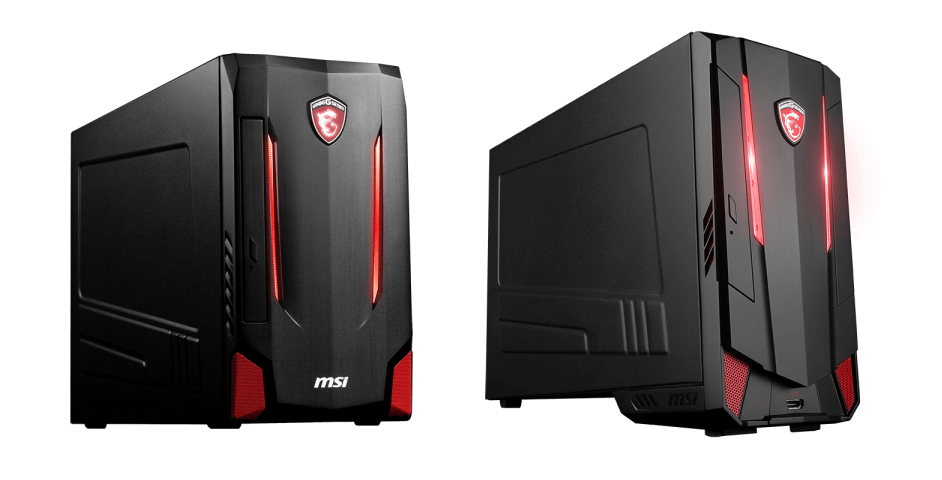
Most SFF enclosures seem to have migrated towards this style for non-HTPC use cases, and for good reason: they yield dimensions that maximize component compatibility within a frame that keeps the footprint on a desk nice and small. In the case of the transition from the MI2 to the MI3, then, MSI didn’t fix what wasn’t broken, instead electing to increase the hight by the tiniest bit in order to accomplish more significant changes to the hardware and exterior. That’s perhaps the by-the-book definition of a refinement rather than an overhaul, and it’s what companies do to products when they think they’re on the right track generation-to-generation. Needless to say, I’d agree with that sentiment.
Alright, that’s enough context. Let’s dig into the details.
Before we review: an explanation of methodology
Before I discuss my experience with the Nightblade MI3, I want to take a moment to discuss the review itself. For this testing, I had just over three weeks of time to use the computer, which was just enough (in my opinion) to get a feel for how it behaves and performs on an ongoing basis. Across this period, I substituted all computing activities at my desk with the Nightblade, and ultimately did pretty much all of the tasks and use cases that I encounter in day-to-day life: web browsing, media editing, working, development, and – naturally – gaming.
The intention (and benefit) of this longitudinal-style testing was to shift some of the focus of the review away from pure performance analysis, and towards the experience of using the machine for myself and others. Consequentially, you’ll notice that the bench testing is somewhat abbreviated, and in a sense this was intentional, as the specifications sheet for the computer speaks for itself with respect to what the expected performance of this machine will be. MSI presents the Nightblade MI3 as the balanced, midrange build that will kill it at 1080p and hold its own in more demanding circumstances (most notably, VR use). As you’ll see in the content of this review, I ultimately think that this assessment is appropriate. But that’s not really the interesting bit.
This isn’t to say that I didn’t run synthetic or real-world gaming benchmarks – far from it! Nor is it to say that I didn’t overclock and test for that as well. Rather, I make this distinction upfront because I believe that reviewing a pre-built machine is fundamentally different from reviewing a discrete graphics card or CPU chip. Because, when it comes down to it, purchasing a prebuilt isn’t about purchasing the components that comprise it – it’s about purchasing the design and engineering and thought that went into how they were assembled, and the experience of using that finished product day-to-day.
That experience encompasses aesthetics, noise, industrial design, and – yes – performance. But that experience should be the focus of the review, which is then accentuated by the performance analysis, and not the other way around.
Receiving and unpacking the Nightblade MI3
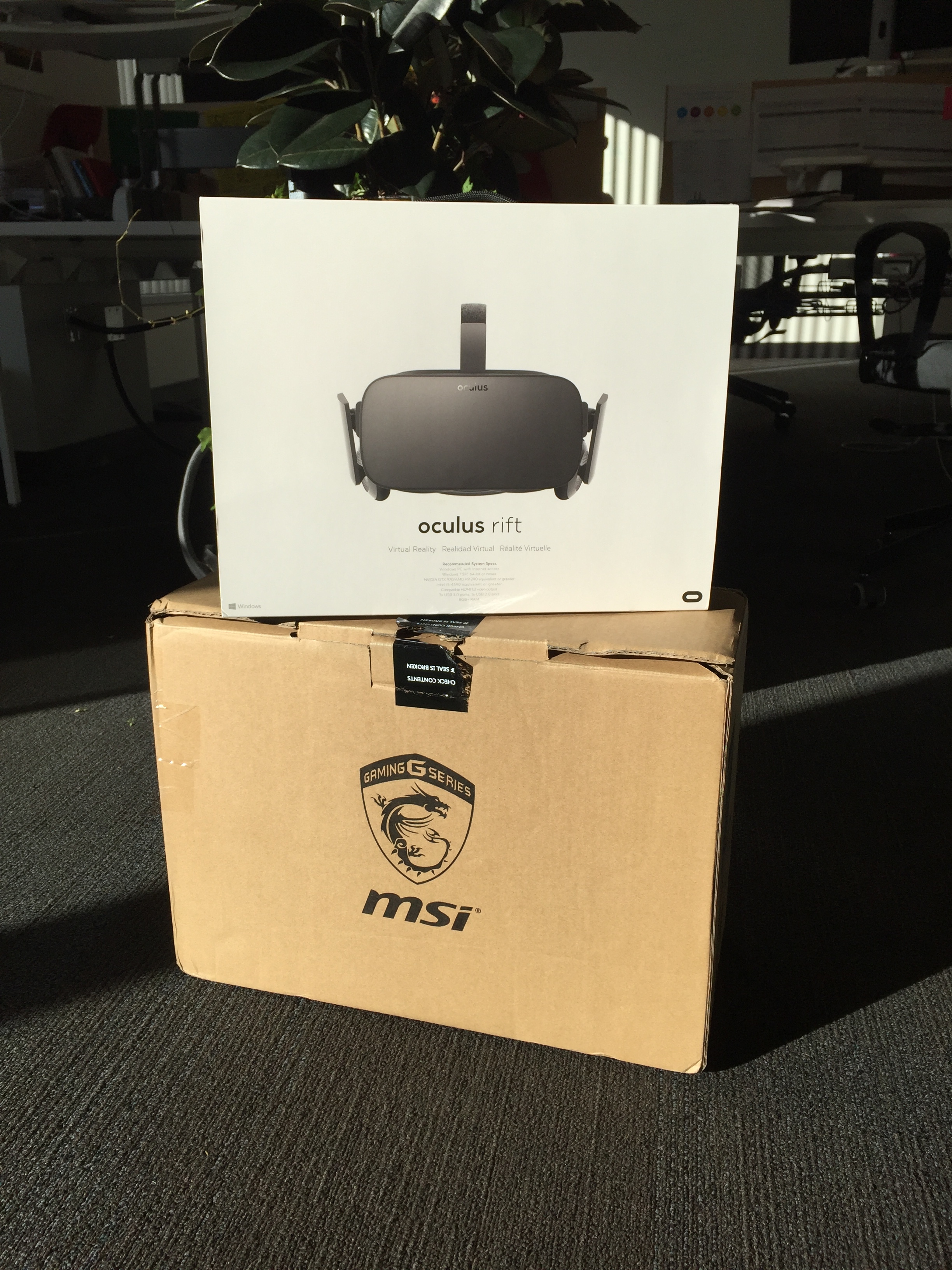
Alright, enough chatter. Let’s begin our review.
We usually have an unboxing section in our reviews, but I’ll have to stick with an abbreviated explanation of what it was like to receive this unit for one simple reason: MSI actually repurposed packaging for the prior-generation MI2 to send it along to me!
(Also, I may have taken terrible photos of the unpacking process. Maybe.)
Anyhoo, this isn’t to say that the packaging didn’t fit the MI3, though – quite the opposite, in fact. Having received plenty of enclosures and whole machines in the mail in my day, I was pleased to see that the unit still arrived impressively well-packed, with a double-box container and custom-cut foam padding ensuring a snug fit within. The PC itself was also sheathed in plastic, offering further protection. Needless to say, FedEx wasn’t putting a scratch or dent on this machine.
One thoughtful touch to the packaging that I particularly appreciated was the fact that the inner box had an integrated plastic carrying handle, which fed through slots at the top of the exterior box to allow for convenient carrying of the whole assembly. As I ended up walking a fair distance while carrying the packaged machine, this saved me a lot of headache. I really hope this carries through to the packaging for all of their computers.
In any case – alongside the desktop computer, MSI had just enough space left to include a small box that comprised the accessory kit. This included a standard power cable, some stickers, and a short HDMI cable (the purpose of which I’ll get to a little later). In other words, everything needed, and nothing else. Perfect.
A first look, from the outside
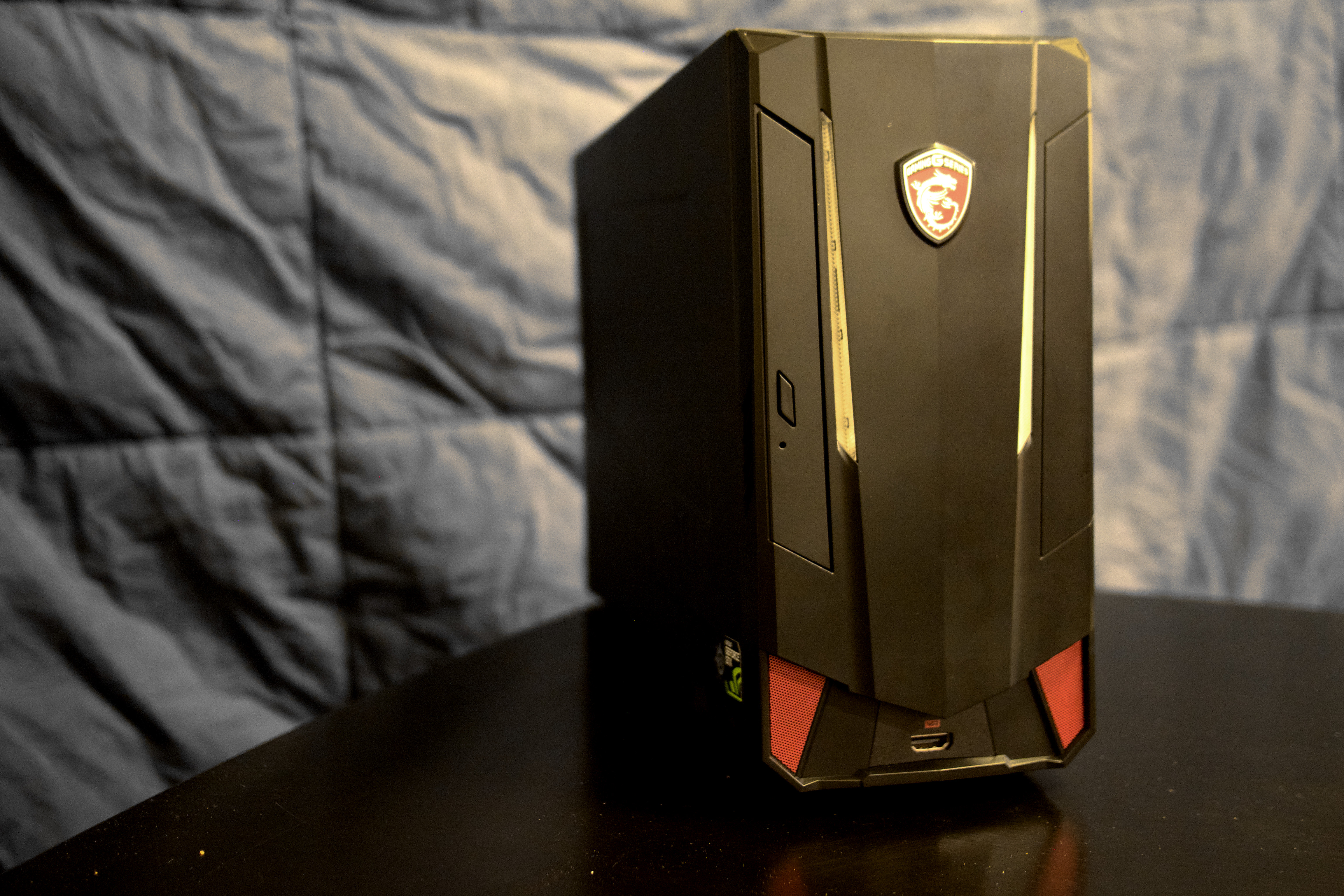
I was excited to peel away the packaging and get a first look at the Nightblade, since in photos it looked quite impressive. Overall, I think that the unit in-person met my expectations, which made me quite happy.
Taking a step back, while in my view it took MSI a while to get to this point, the MI3 (not to mention the other pre-builts they have) finally seems to have a distinctive aesthetic that distinguishes it as an ‘MSI’ machine, and not ‘just another gaming rig’. To my eye, at least, the older design of the Nightblade (seen earlier) – and older MSI designs more generally – tended to be a bit more generic in appearance, with features that look fairly flat in comparison to the current lineup. Perhaps this is an instance of hindsight being 20/20 in the presence of new hardware, but suffice it to say that I give much higher marks to the MI3 than to its predecessors in the looks department.
That said, the aesthetic itself of the Nightblade is a little hard to describe. The dragon badge gracing the front of the computer is reminiscent of a fine sports car, but the faceplate is decidedly armor-like in appearance. Couple this with a few blood-red grills at the bottom, and the lighting elements flanking the center, and you have… well, something that looks pretty cool, I’ll admit, but without a theme to call it other than “MSI-y”. Perhaps that amalgam of design inspiration is what gives it such uniqueness, though.
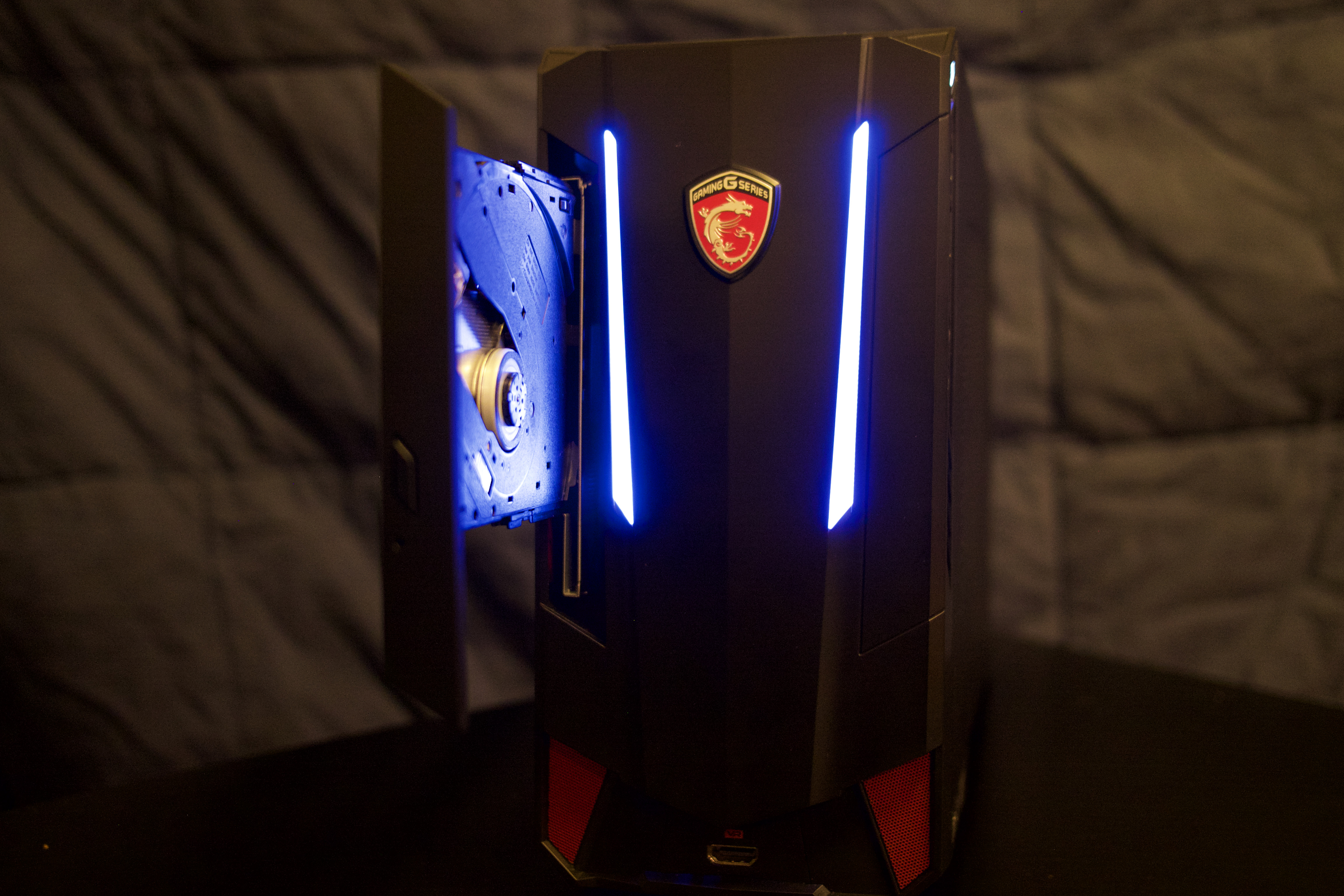
That aside, I do really like where the ‘MSI aesthetic’ has ended up in this instance. The MI3 retains the energy and edge that nearly all gaming machines attempt to covey, and allows itself a degree of flair with the lighting and more detailed faceplate. But it does all of this in a constrained (or at least constrained enough) way that looks handsome, rather than ostentatious. For that alone, I really respect the design.
Given that we now live in a world that shuns anything that doesn’t have lots of colorful lights on it, I suspect that most users will find the RGB lightstrips gracing the front to be the most visually interesting bits of the machine, and they certainly work and look as advertised. For me, though, the neatest part of the Nightblade is almost certainly the effect whereby the lit shroud of the graphics card illuminates through the vented side panel. In a lit room, this effect is very subtle; switch off the lights, however, and the computer transforms into a compact node with fragments of red light trying to shine out. It’s a neat effect, and one that photos don’t do justice to. You’ll look pretty badass at a LAN party with this rig at your side.

With respect to the materials selection, we don’t find anything out of the ordinary, and that’s perhaps for the best. The sides and top consist of a uniform shroud of stamped steel, powdercoated to a matte black finish. Meanwhile, the faceplate is made of molded plastic that’s more satin in appearance, and felt durable enough. I’m a sucker for luxe materials and finishes, so there’s perhaps a little disappointment that there weren’t any particularly impressive or exotic uses of materials. But then again, that tends to translate into really expensive builds.
Setting up the Nightblade MI3
Much like a console, MSI made set-up for the Nightblade trivially easy. As I did all of the testing on a 1080p television and a 1080p monitor, I simply plugged an HDMI cable into the rear, plugged a power cable into the same, and booted the machine up. A Win10 boot screen greeted me, and I was good to go.
Once I set the appropriate software up, I was also pleased to see that MSI was fairly light-touch with adding software above and beyond the default Windows experience. If anything, I wish they had included more – the MSI ‘Gaming Center’ app, which controls the RGB lighting and provides some other features, was included, but Afterburner was not.

Finally, while I was initially confused with the inclusion of a short HDMI cable, all became clear as I first configured the machine: in a bid to orient the Nightblade MI3 towards VR enthusiasts, MSI provides an HDMI port at the front of the machine that essentially acts as an extension cable running through the length of the computer. Thus, the port on the front runs to an identical port on the back of the machine, which is meant to be connected directly to the graphics card via the included HDMI cable. It’s low-tech, for sure, but it’s pretty clever, and a thoughtful enhancement given the target market. It reminded me of when case manufacturers did a similar thing with USB 3 ports, when they were so new that motherboards had them in their rear I/O, but didn’t have headers for them yet.
Booting the Nightblade MI3 up
As I mentioned before, the benchmarks I ran for this review aren’t quite as thorough as those that we’ve done for certain product reviews, and this is mostly because the Nightblade is a known quantity – we have specific expectations for what the performance will be like, and it doesn’t take much to confirm those.
Before we dive into the testing I did, however, we’ll need to know the specifications of my particular review unit! So here they are:
| OS | Windows 10 Pro 64-bit (6.2, Build 9200) |
| CPU | Intel Core i5-7400 CPU @ 3.00GHz |
| GPU | NVIDIA GeForce GTX 1060 6GB, 6379MB (Driver Version 378.66) |
| RAM | 16GB DDR3 RAM |
| Storage | Intel SSD 600p Series 250GB M.2; Seagate 1TB 3.5″ HDD SATA 3 |
| PSU | MSI 350W 80 Plus Bronze PSU |
| ODD | 16x DVD-RW |
The IO is as follows, for the front:
- 1 x USB 3.1 Gen 1 Type C
- 1 x USB 2.0 (with Super Charger 2)
- 1 x HDMI out (VR-Link)
- 1 x Mic in / 1 x Headphone out
Meanwhile, on the rear (excluding the GPU, which has an HDMI port and 3x DisplayPort):
- 4 x USB 3.1 Gen 1 Type A
- 2 x USB 2.0
- 1 x HDMI out
- 1 x HDMI in (connect Graphic card and front VR-Link port)
- 1 x Display Port
- 5 x OFC Audio jacks
- 1 x S/PDIF
- 1 x RJ45 LAN
- 1 x Gaming device port (PS/2)
Before we even turn the computer on, we can make some observations about the component choices by MSI, and the implications of those. To start, I’m very happy to see that MSI has gone with a desktop-class processor for the MI3, given that many pre-builts of this size have the terrible (and misguided) habit of introducing laptop/mobile silicon into the fold, in order to keep temperatures under control. The i5-7400 is a fine choice of processor, and with gaming I would not expect it to get in the way of the GPU in most instances, at least in the medium-term.
I’ll mention at this point that the chip is able to Turbo Boost to 3.5Ghz, and I had no trouble seeing that level of performance during casual use (when only a few cores are being utilized). That speaks well to whatever cooling system they’ve devised, which we’ll tear apart (literally) later.
The GTX 1060 graphics card is also a good choice, at least in my opinion. The specific card they’ve gone with is well reviewed, and the card itself exists at the apex of performance and value on nVidia’s lineup presently. Given the performance level of the i5-7400, this is also a well balanced selection, and I don’t anticipate that either of the CPU or GPU will consistently bottleneck the other. Finally, the enclosure lends itself just enough space to contain the oversized cooler on MSI’s 1060, as well, so it’s clear that there would have been potential design or other compromises had MSI chosen to go any other way.
Lastly, the I/O and storage check all the boxes I would expect them to: MSI has elected to provide a fast-but-small ‘boot drive’ in the form of a 250GB M.2 SSD, but has complimented this with a 1 TB HDD that provides a more generous helping of storage at a palatable price. I’ll have more to say on the storage front once we open the computer up, but suffice it to say that this hybrid storage approach is very common in the midrange market, and while I’ve generally argued for smaller and faster storage, it’s a reasonable compromise and I won’t complain about it. (Much.)
Alright, I think that covers everything. I’ll have more photos of the enclosure in a bit, but for now let’s get to benchmarking.
Running the gauntlet
Most reviews typically divide testing into synthetic benchmarks and ‘real-world’ gaming benchmarks, and this review is no different. For synthetics, I performed Fire Stike Extreme, Fire Stike Ultra, and Time Spy, all on a 1080p monitor, to provide a basis for relative comparison against other builds and pre-builts. For real-world benchmarks, I ran the following, all also at 1080p:
- GTA V: Very High all-around, 4x MSAA
- Metro 2033: Very High all-around, 4x MSAA
- Hitman: Absolution: Ultra all-around, 4x MSAA
Per the aforementioned technical specifications, I used the latest Win10 Pro version and nVidia drivers at the time of testing. These tests were run at the GPU’s default setting, which was ‘Gaming Mode’, and provided a base clock of 1569Mhz with a boost clock of 1784Mhz (which was generally sustained throughout all of my testing). All tests involved executing the benchmark alone from a cold boot following a 5 minute waiting period, across five separate runs, the sum of which was averaged.
| Fire Strike Extreme | Score: 5580 |
| Fire Strike Ultra | Score: 3001 |
| Time Spy | Score: 4082 |
| GTA V | Average FPS: 97.4 |
| Metro 2033 | Average FPS: 84.6 |
| Hitman: Absolution | Average FPS: 66.5 |
Simply put, I don’t find any surprises here. I’ve essentially cranked the settings on all the games I tested, and at 1080p frame rates remained quite strong. Anecdotally, I made a point of watching each run to ensure that there weren’t persistent issues with dropped frames or inconsistent framerates, and beyond the more intensive elements of the synthetic benchmarks (in particular the latter part of the Time Spy runs, when the big monster starts destroying walls) there was also no noticeable issues with dropped frames. When focusing on the gaming experience exclusively, each run was very consistent, and I consider that to be an important win for MSI – there seem to be no engineering, thermal, or other implementation issues that are leading to degradation in performance.
VR testing, social-experiment style

Although I have no benchmarks for this (as I couldn’t put together a setup that I felt would appropriately measure VR performance), I simply had to find a way to incorporate VR use into this review. MSI is very heavy-handed in their marketing of this machine with respect to its ‘VR-readiness’. And, to be blunt, I was highly skeptical of this, because at the end of the day they were attacking VR performance (a very demanding use case) with midrange hardware. Compromises would have to be made in visual fidelity to keep frame rates adequate, and I wasn’t sure how impactful that would be to the experience.
As such, I decided to perform a bit of a social experiment. With an Oculus Rift headset on loan, I brought both the headset and the Nightblade MI3 into my workplace one late Friday afternoon, and asked for volunteers to do some ‘testing’ of the whole kit.
The selection of my co-workers as the test population was quite deliberate: as I currently work at a healthcare startup in Boston, the cross-section of individuals who’d be able to test the VR experience ranged from younger co-workers that already owned headsets, to the older guard that had limited-to-no exposure to VR, or even to gaming in general. Thus, for this ‘testing’, I had each participant walk through the Oculus Dreamdeck demo, and then gave them the pick of three games to try out: Lucky’s Tale, Minecraft for VR, and Keep Talking and Nobody Explodes. I made a point of being as non-descriptive as possible about the games/hardware/experience as possible, in order to avoid biasing feedback or setting expectations. And I took notes. A lot of notes.
The feedback was fascinating. As I’ve spent time trying to distill the feedback I collected from everyone who played with the system, it’s clear that three different camps emerged: those who had lots of VR exposure already, those who had some passing exposure or interest, and those that had no idea what they were getting themselves into.
The latter group, as expected, was simply blown away from using the Rift, and (crucially) reported back no symptoms of nausea, though a few felt some serious vertigo from the skyscraper scene in the Dreamdeck demo. The middle group – those with some VR exposure – shared similar feedback, though one individual complained about stuttering in Lucky’s Tale that put them off of balance.
The last group – the VR veterans – were a bit more critical of the setup. One player immediately complained of the reduced texture quality, lack of antialiasing, and lack of shadow or reflection details, for instance, even as they praised the (unexpectedly) smooth framerates. Others reported back that they weren’t as captivated by the scenes, though they couldn’t distinguish whether or not this was from repeated exposure or from anything specific to the MI3’s rendering capabilities. All-in-all, the sentiment of ‘good but not great’ as described by on of my first testers seemed to come through the strongest.
…So where does that leave us? Admittedly, none of this feedback is empirical, but I will say that the aggregate commentary from everyone matches my own sensation when playing VR on the MI3: It’s a solid and consistent experience, and unless you’ve played the same titles on far more expensive hardware, you’ll be more than adequately captured by the experience, medium texture settings be damned. And that’s pretty exciting for those in the market for a pre-built that’s aimed in the middle price bracket. I honestly would not have expected as strong and consistent a showing as we got.
Taking the Nightblade MI3 apart
With the initial testing done, and with MSI’s permission (speaking of which, my thanks to MSI for letting us do this!), I was now ready to take my tools to the MI3, and get a sense of how the unit was made. Needless to say, I made quick work of tearing the machine down.
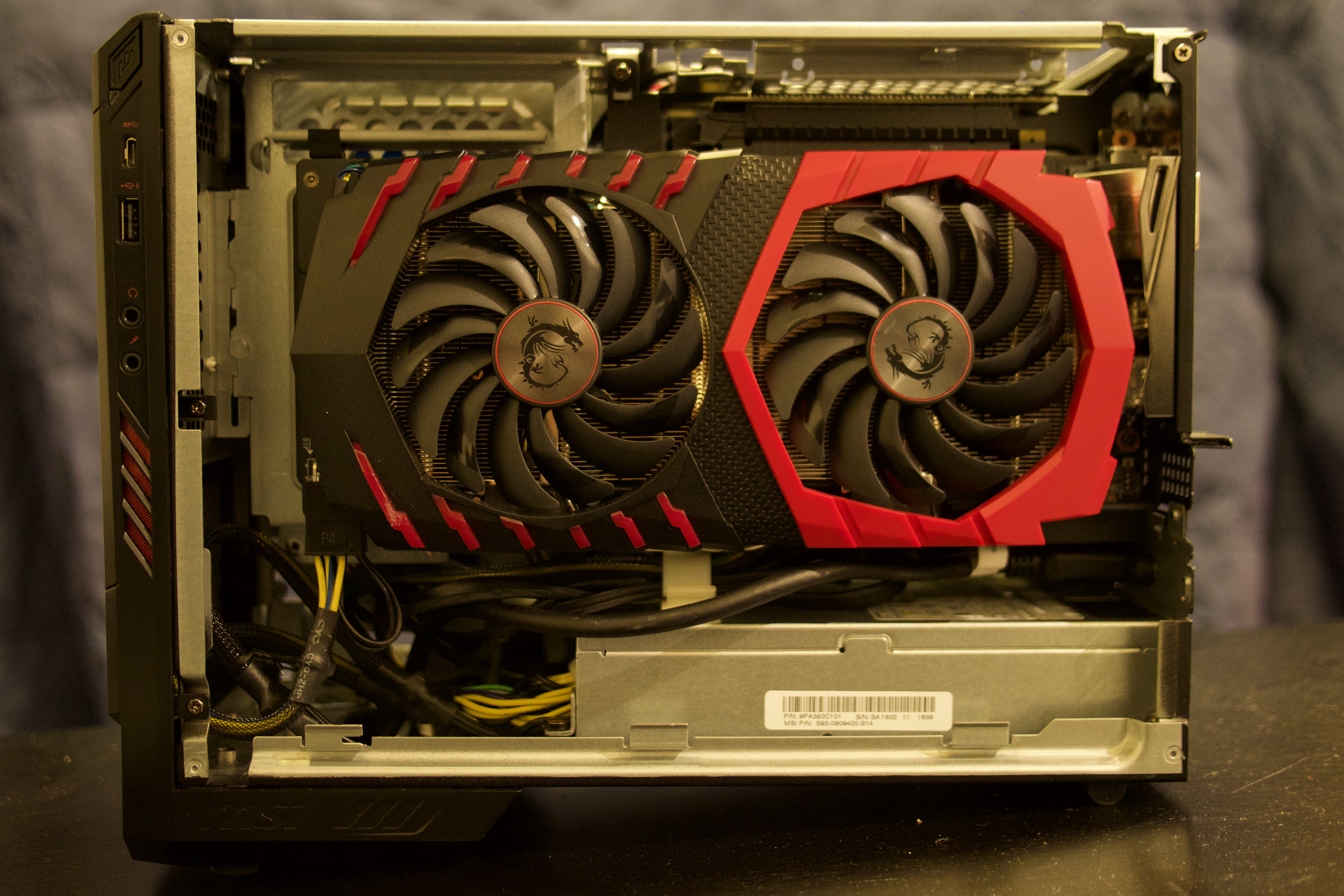
The MI3 makes it trivially easy to remove the metal sheath covering the top and sides of the enclosure. Following the removal of a few screws on the back of the case, the entire internal frame is exposed, with the graphics card prominently mounted on the right side, positioned to pull air from above and exhaust it in the rear. Above, you can see not only the graphics card, but the 1U power supply that lies beneath it – as well as the rigid PCI bridge that allows for MSI to orient the graphics card in this way.
A bit harder to see is the hard drive cage towards the front of the unit, which resides behind the GPU to the left in this photograph.
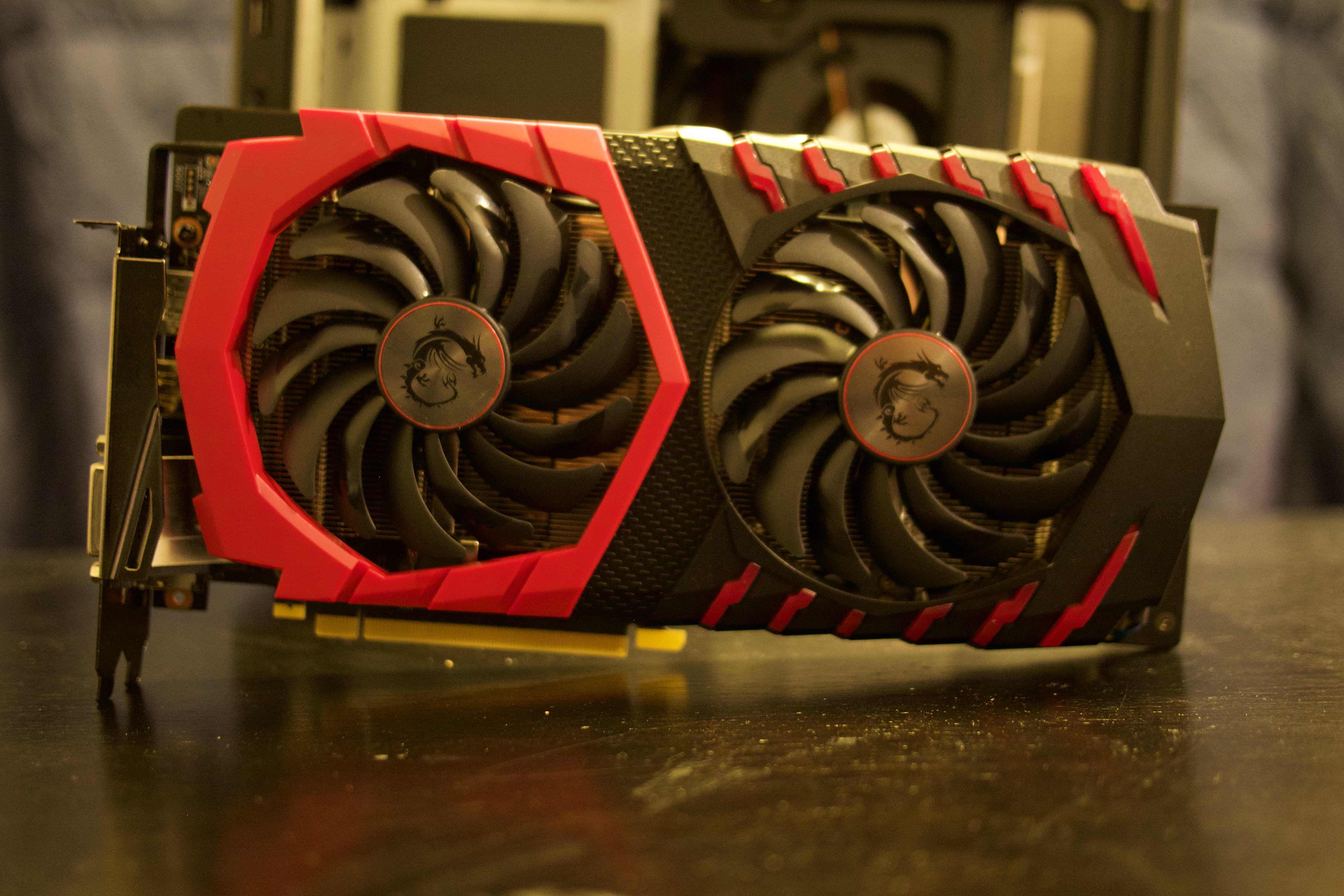
Pulling out the graphics card for a moment, we find MSI’s take on the GTX 1060, oversized shroud and all. And I don’t say oversized lightly – the PCB, cooler, and fans all extend well beyond the height of the PCI bracket, and (if the last photo wasn’t any indication) it’s a cozy fit between the PCI bracket and the PSU at the bottom of the enclosure.
Let’s turn back to the build, however. Now that we’ve exposed the top and sides, we can take a look at each, starting on the left side (opposite of the graphics card):
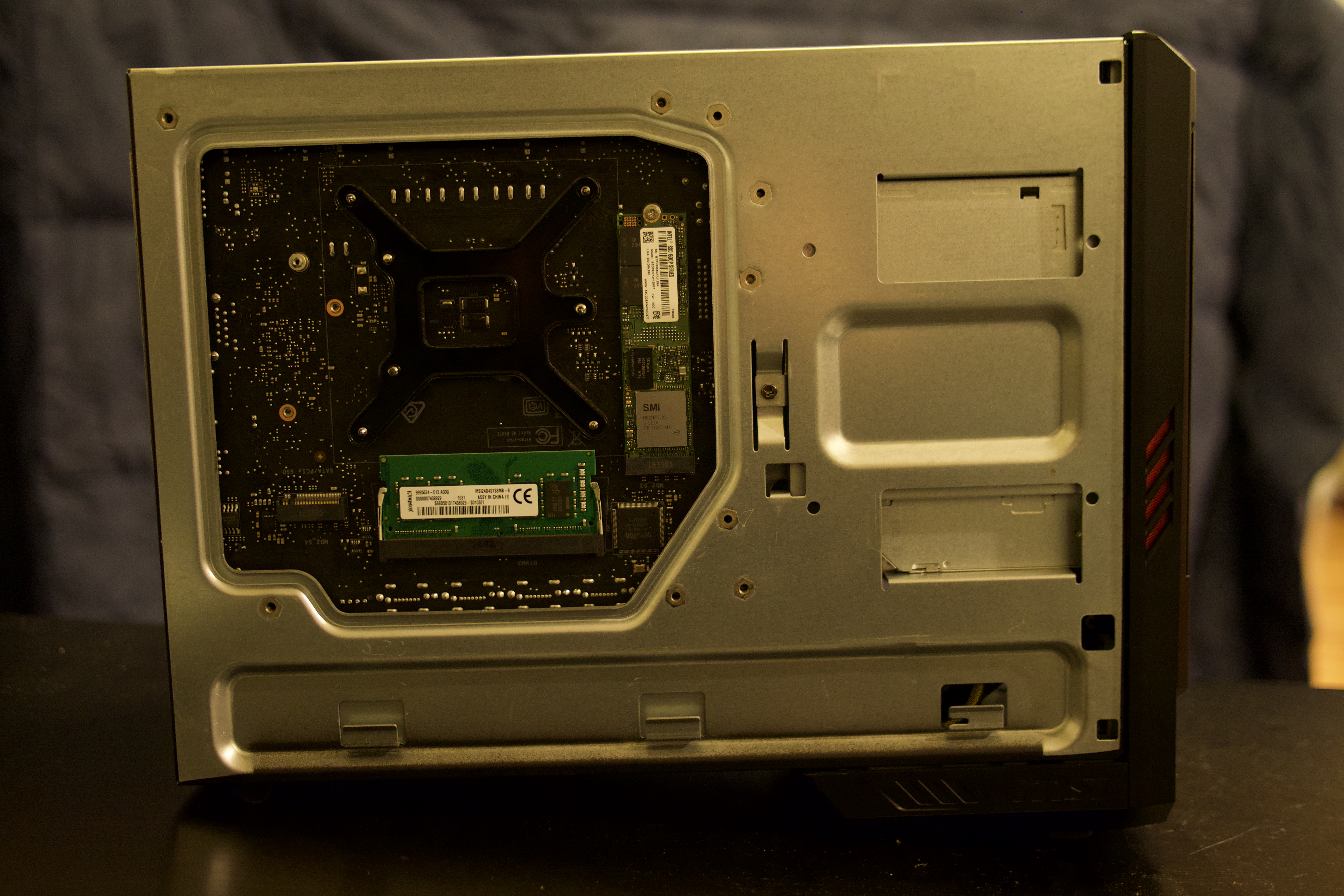
Here we can see that MSI has provided a very generous motherboard trey cutout, in order to support the installation of a few bits of hardware. For starters, we have not one but two M.2 slots here (one of which is re-populated), enabling a whole host of future upgrades. Given that M.2 capacities remain restrictively low, this is great to see.
You’ll also notice that we have a solitary memory module having out just below the CPU socket. The motherboard actually supports two SO-DIMM slots, and up to 32GB of RAM, but MSI has elected to put one of these slots on the back of the board. I’m not precisely sure what the rationale was for doing this, but as we’ll uncover the cooling solution implemented for the CPU, I think it’s reasonable to assume that MSI was concerned either with thermal performance, or with clearance. Perhaps both, come to think of it.
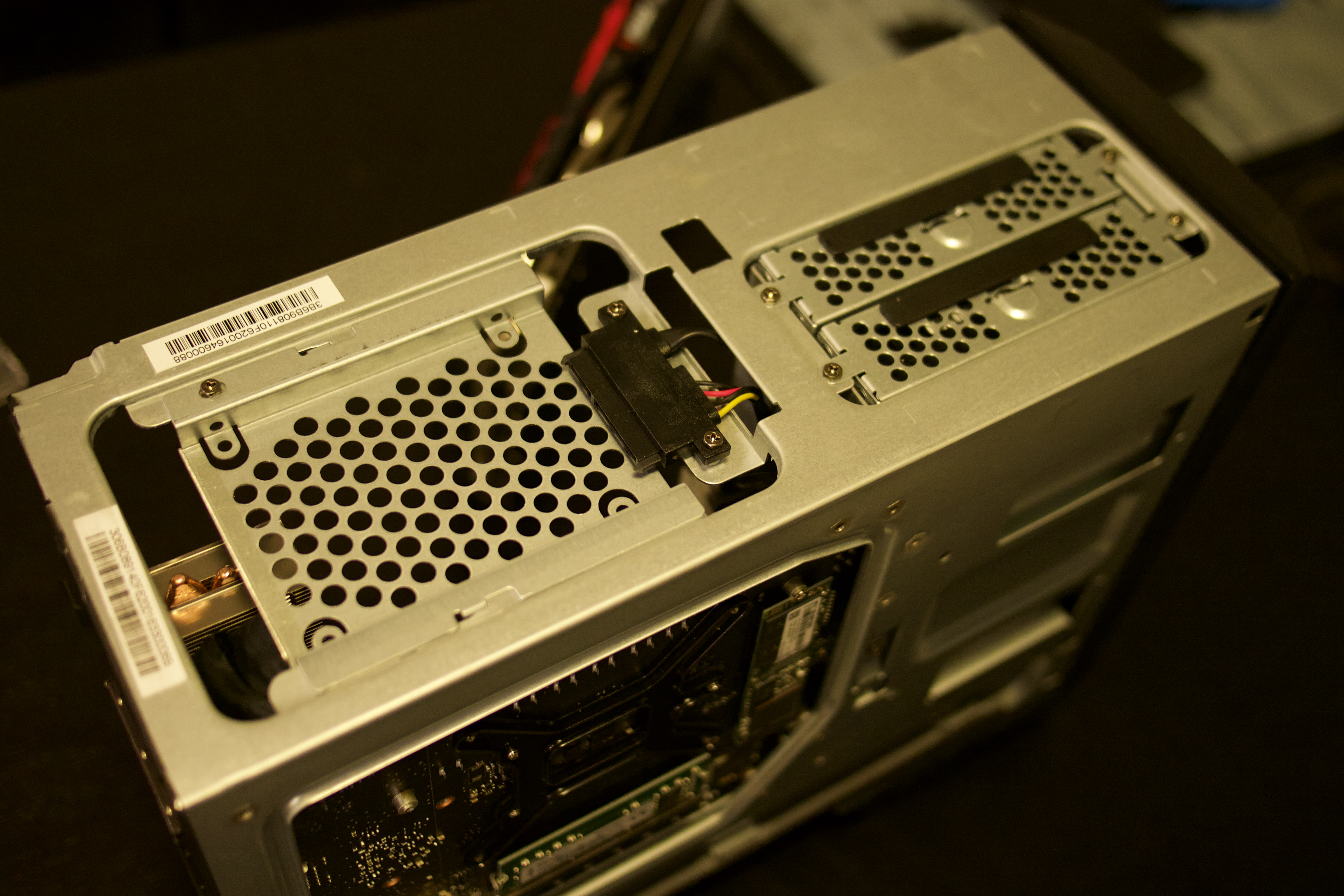
Shifting our attention to the top of the enclosure, we see even more storage options. Towards the back of the case, MSI has pre-installed the data and power wiring necessary to put in place a 2.5″ drive. Meanwhile, to the front of the enclosure is a dual-3.5″ bay for a pair of HDD’s, one of which comes pre-populated. These, too, are wired and ready for devices, further easing and expanding the storage upgrade paths available to owners.
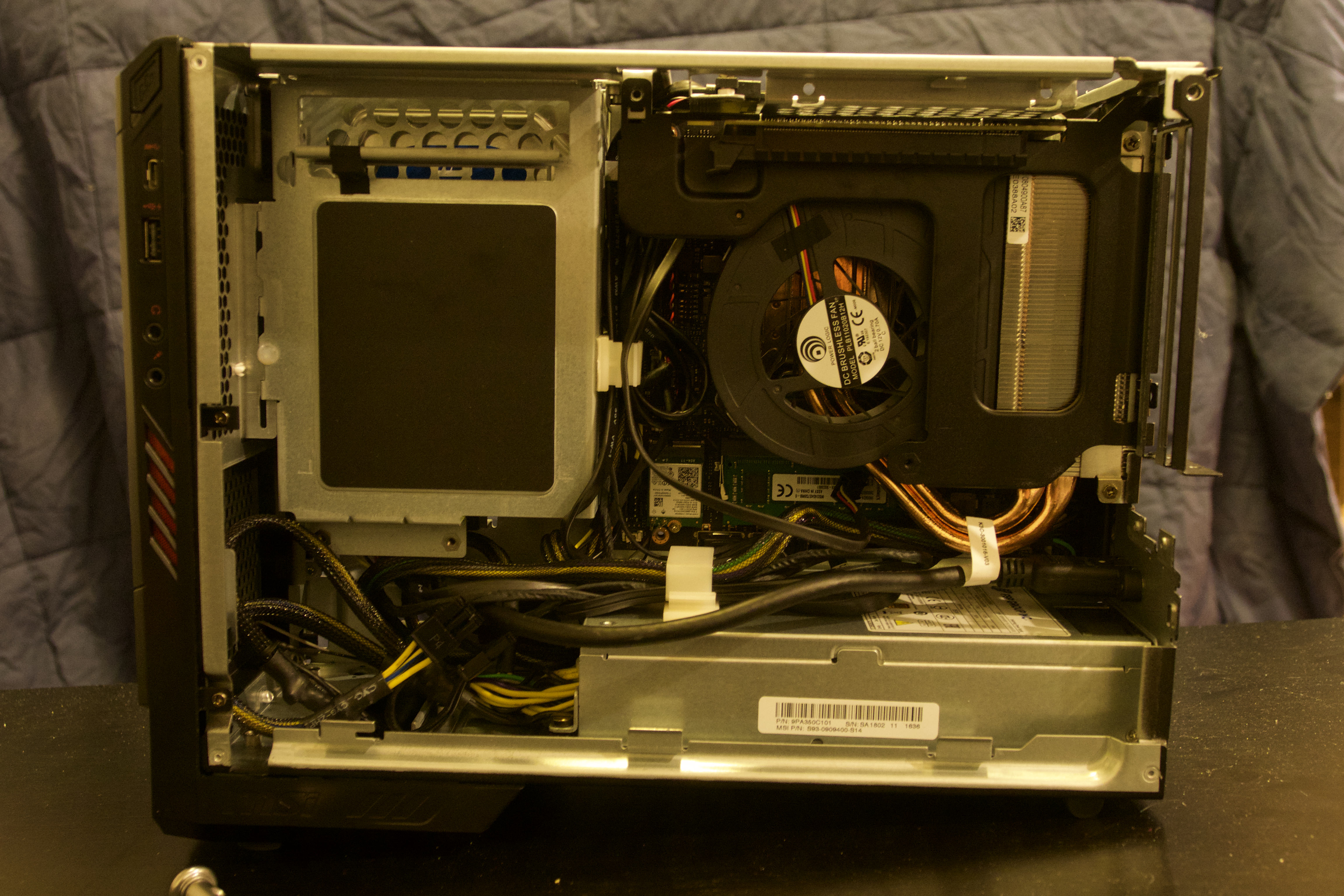
Back to the right side, and we can now look into the chassis and get our first look at the motherboard and remaining components. As before, the PSU lies on the bottom, and we can begin to see some of the clips and ties MSI has used to try and keep cable clutter at a minimum. More interestingly, however, we can see a few custom parts that MSI has crafted specifically for the Nightblade MI3: the CPU cooler, and the rigid PCI bridge.
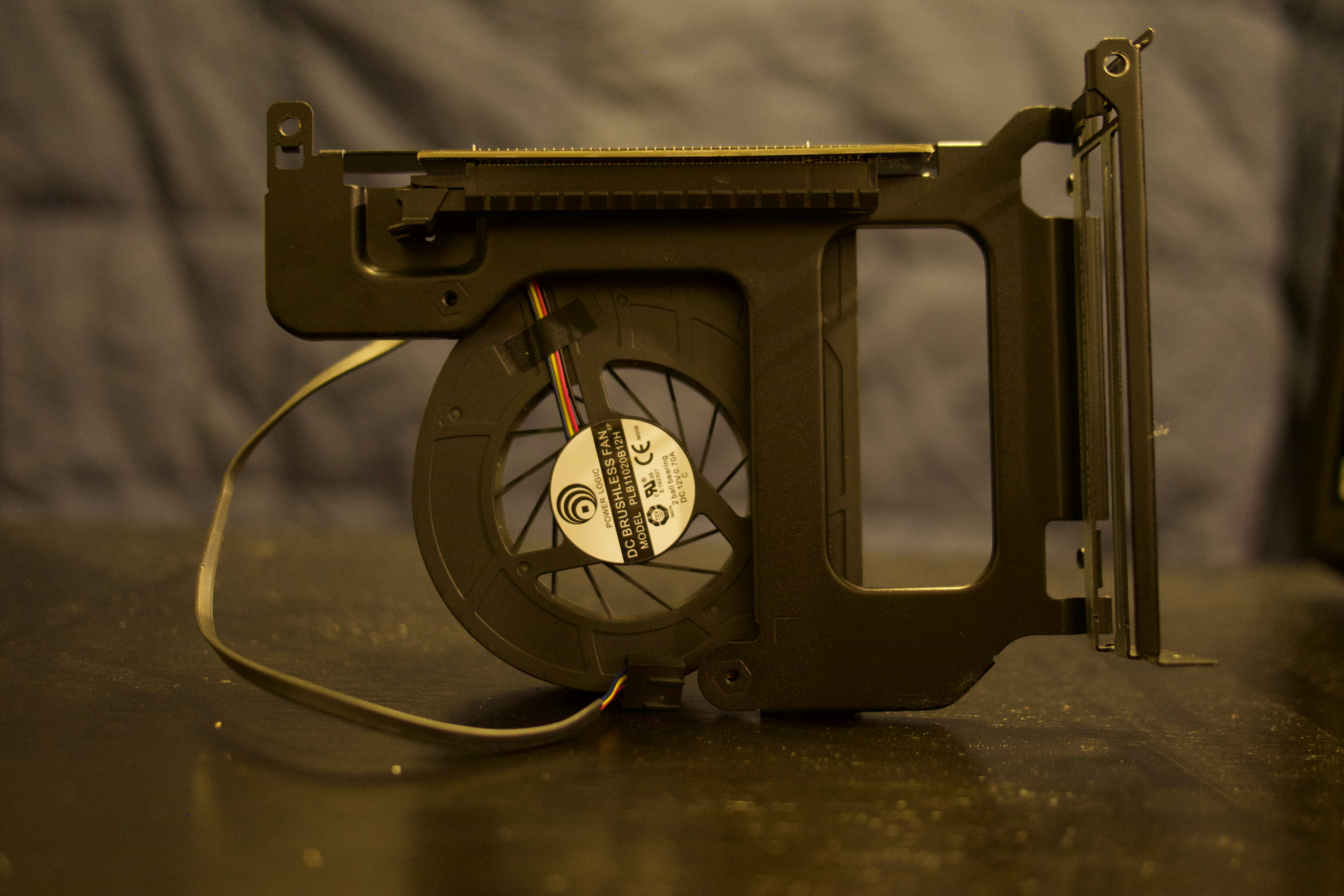
Pulling the bridge out, we see that this is actually a fairly complicated piece of engineering, integrating a bunch of things into one piece. The fragile silicon bridge is given some much-needed reinforcement, and the metal bracket providing the extra strength and rigidity is also home to the fan that is responsible for cooling the CPU! Further, all of this is integrated into the chassis and actually provides the structure for the PCI slots that the GTX 1060 slides into when installed.
This might seem a bit excessive for one solitary part to do, but bear in mind that, by combining all of this functionality into one part, that MSI has likely simplified their manufacturing and assembly requirements, all while improving durability and rigidity now that there are fewer parts to deal with.
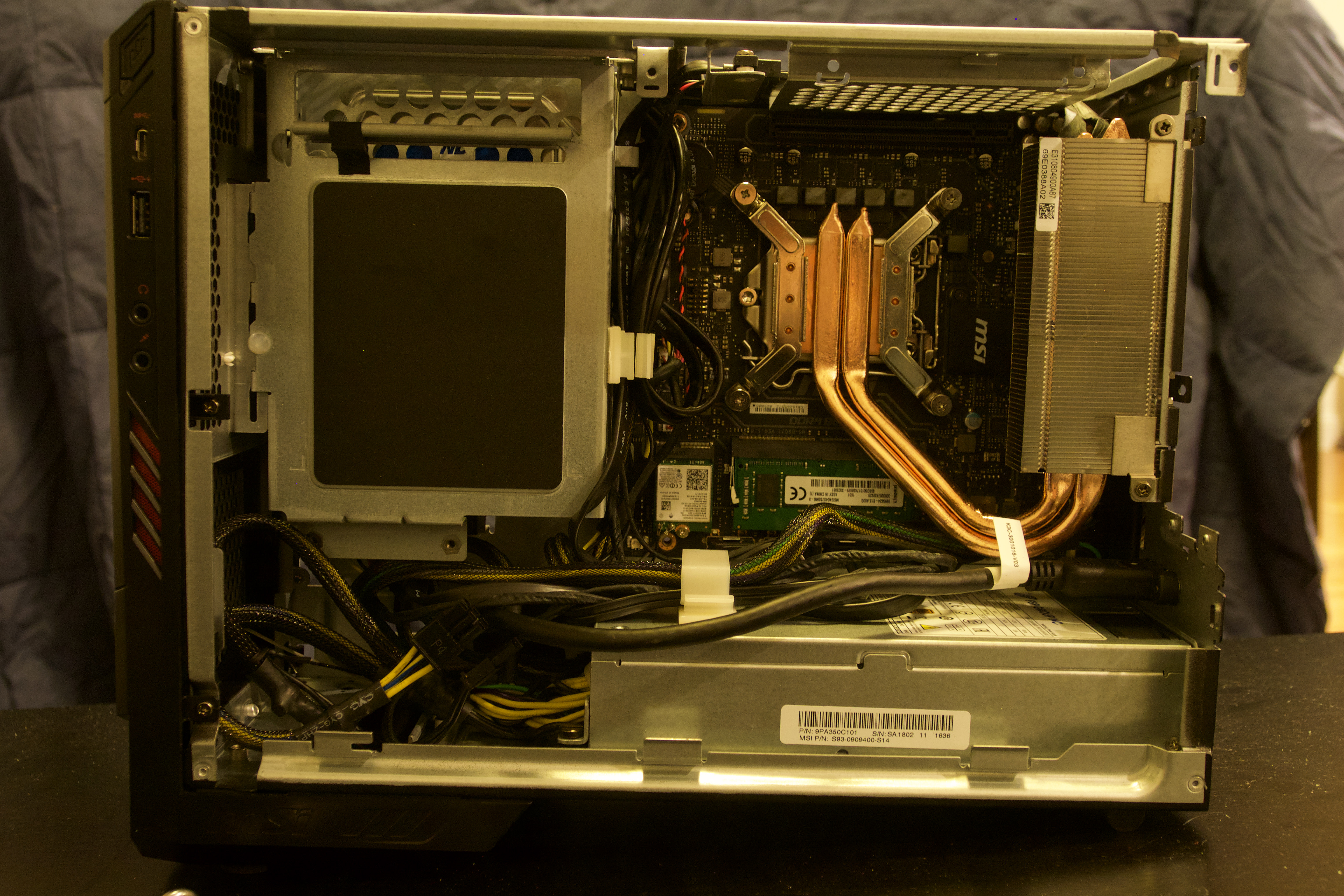
As we’ve now removed this part, though, we can finally see the exposed CPU cooler – and it’s really something! In order to keep the width of the MI3 as compact as possible, MSI couldn’t stick with a traditional top-down cooler, as this would be far too tall. Instead, they’ve laid a pair of copper heat pipes which snake below the CPU fan, and then wrap back up to run through a block of aluminum mounted at the rear of the case. The CPU fan then blows laterally across these fans, intaking air from the inside of the case, and expelling it out the back.
This sort of cooler design is quite typical in mobile or all-in-one contexts, but it’s more unique to find in the MI3 given that we’re talking about a desktop computer, and a desktop-class processor. I’ll admit that, were I to have discovered this before I ran any tests, I’d be very concerned about the thermal and/or raw performance of the CPU, since such long heat pipe runs typically translate into poorer cooling performance. However, since we already know the performance characteristics of the build, we know that there isn’t much to worry about here (thankfully, and impressively, enough).
Finally, one last bit that I want to call some attention to: the cable management. I can’t even begin to express how terrible the cable management can be in some pre-builds, having had experience with units from Cyberpower, Dell, Lenovo, and others. MSI has done a very good job keeping cable runs under control, however:
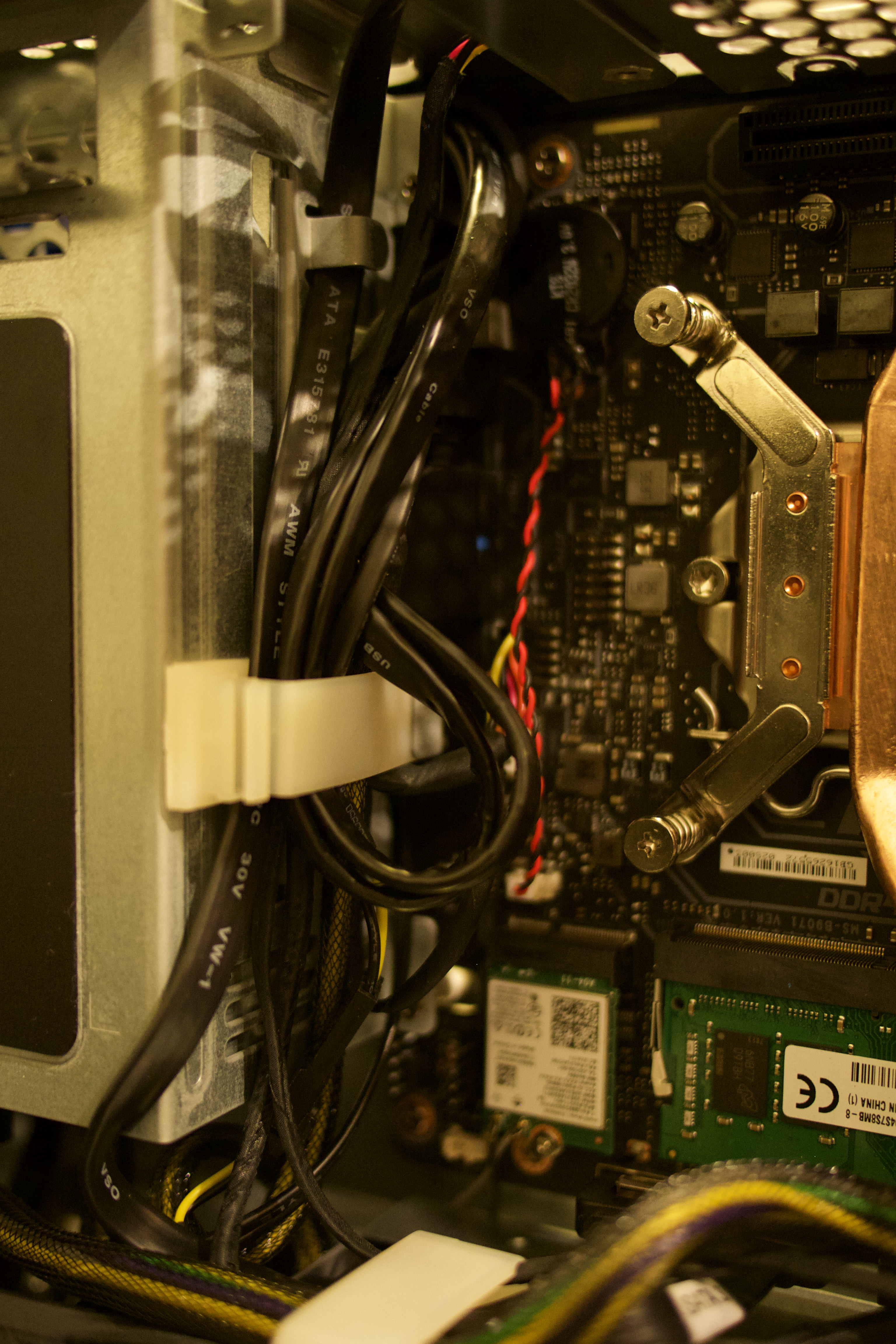
This is doubly impressive when you consider that they’ve got an HDMI extension cable running through the enclosure, as well as all the extra SATA and power cables that are hooked up to the as-of-yet unused storage bays. That picture probably doesn’t make it look all that pretty, but what matters more is that it’s organized.
Of course, it may very well be the MSI didn’t have much choice but to keep the cabling reasonable organized, either due to assembly concerns or performance/thermal ones (as rats nests of cables can easily suffocate cooling systems in the long run). But even so, it’s worth calling out! Good on them for practicing good cable hygiene.
Overclocking the Nightblade – or, more specifically, the Nightblade’s graphics
I should start with the bad news first: As the i5-7400 and the B250 chipset don’t allow for frequency tuning, CPU overclocking was out. I don’t know that this ultimately left much performance on the table, however, since the compact build and underlying cooling solution likely wouldn’t have provided much thermal headroom to begin with.
Consequently, I got to turn the whole of my attention to tuning the GPU instead. To overclock, I installed the latest version of MSI’s Afterburner, and essentially went for the moon, starting with an artificially high clock speed and then stepping down and testing repeatedly until I found a reliable OC.
I used both Unigine Valley and Heaven to test for stability, as well as Prime95 for the CPU. Once I was able to execute two 20-minute concurrent runs of each of the graphics benchmarks, I considered my overclock stable.
So, how’d the Nightblade MI3 do? We started at 1569/1789Mhz clock (and 8000Mhz for memory), and we ended up here:
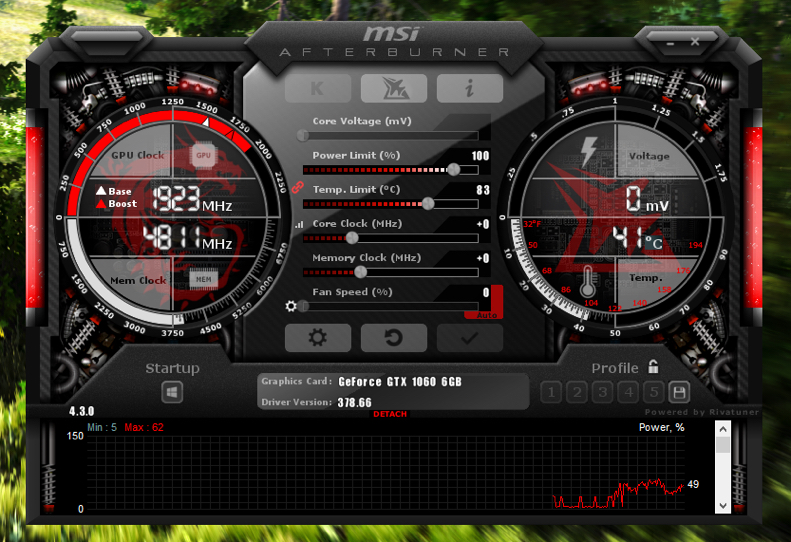
As for the clock speed: not bad, I’d say, albeit nothing particularly dramatic. A result of 1923Mhz translates into an increase of around 8 percent, which will certainly help whenever frame rates are struggling, but realistically won’t do much else.
As for the memory: holy crap! Bear in mind that you have to double the number displayed in Afterburner, so this represents a 1.6Ghz overclock on the memory, or a 20% improvement. That’s pretty crazy.
How did this affect our earlier benchmarks? Take a look:
| Test | Base | OC |
| Fire Strike Extreme | Score: 5580 | Score: 6163 |
| Fire Strike Ultra | Score: 3001 | Score: 3390 |
| Time Spy | Score: 4082 | Score: 4495 |
| GTA V | Average FPS: 97.4 | Average FPS: 106.0 |
| Metro 2033 | Average FPS: 84.6 | Average FPS: 90.1 |
| Hitman: Absolution | Average FPS: 66.5 | Average FPS: 71.9 |
Overall, we see a net effect of around a 10% improvement in synthetics, and a more mixed improvement in real-world testing that averages to about the same. So, not transformative, but hey – it’s free performance.
Notes from extended use
Lighting
I was a little concerned that the lighting from the case might be distracting at night (since my desk is in my bedroom), and my concerns were warranted – those RGB’s are bright, and that’s only a great thing until you want to get some sleep. Thankfully enough, turning the computer off or disabling the lights with the included software makes this a simple issue to fix, so my complaints are minimal.
Noise
At idle, the computer was reasonably quiet. It won’t come as a surprise that the PSU fan was generally the culprit of any detected noise – and to that end, this likely explains why the MI3 is never completely silent – but it was an even white noise, and was not very distracting.
This was essentially the experience for 80-90% of my own use of the Nightblade, since a lot of the work I do leads to ‘busy’ workloads that don’t necessitate spinning up the fans, unlike a sustained job like encoding or rendering. Once you start to ask a lot of the Nightblade, however, all of the fans compete make themselves known.
Perhaps thanks to its location in the belly of the computer, the CPU fan itself never proved to be completely irksome, but when running each one of my benchmarks the twin fans cooling the graphics card arrived at the forefront of the acoustic profile of the case, spinning up quickly and maintaining a strong flow of air until the testing ended.
Crucially, the one saving grace is that the noise remained consistent and soft, and I was never able to detect any clicking or vibration throughout my use. In my opinion, the majority of customers will not be terribly bothered by the loudness of the fans, so long as they don’t have a habit of playing in a silent room – even medium volume music or gaming pushed the cooling apparatus into the unnoticed background. In this sense, I’d say that the MI3 exceeded my expectations somewhat – lots of small gaming rigs are panned as veritable turbines when running full-blast, but the MI3 manages to keep the noise under control.
General behavior
After adding it all up, it turns out that I spent nearly 70 hours using the Nightblade for personal or work-oriented tasks, and overall I walked away from that use a happy camper. Although I did not do any serious rendering or compilation, at my peak I had dozens of browser tabs and documents open, alongside a video, some photo editing, some web development tasks, and some downloads and encoding tasks, and not once did I suffer any significant disruption to my workflow.
At peak demand, I was utilizing 9.6 GB of memory (out of 16GB installed), and CPU utilization was maxed out as Handbrake worked to encode some videos. At worst, in these circumstances I encountered some stuttering when pushing windows around, but it was otherwise a very fluid experience.
Finally, application launches and media editing was consistently snappy, thanks to the M.2 SDD included in the configuration I tested. It was a bit frustrating to have to decide what to install or store where later on in my longitudinal testing (since I quickly filled the 250GB M.2 drive and ultimately had to shift some content to the HDD), but that feeling of snappiness never felt degraded as a result.
Final Remarks
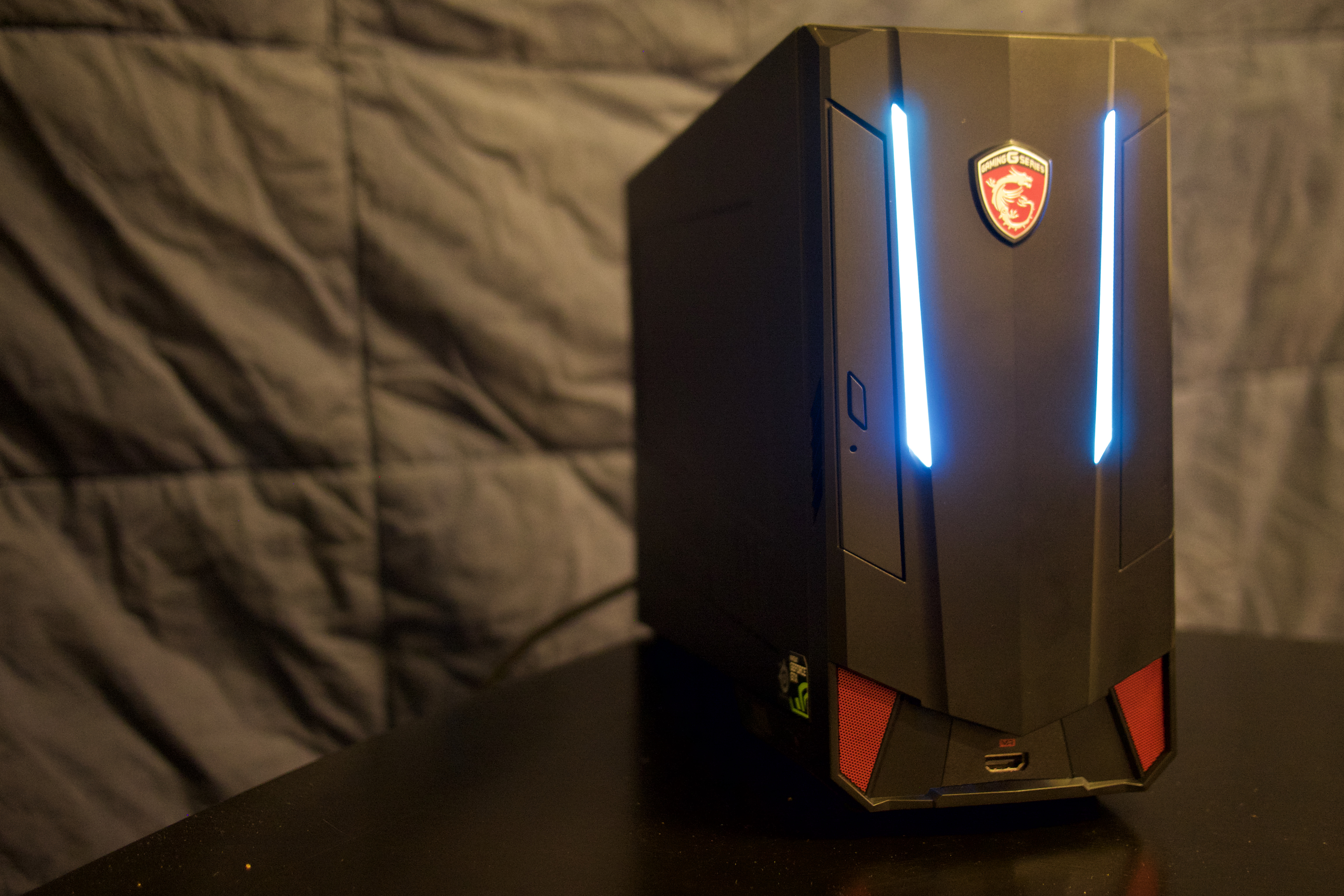
I really enjoyed my time with this computer – using it day-to-day, putting it through its paces, and spending a lot of time thinking critically about its design and characteristics in my day-to-day workflow. However, it’s clear to me that the Nightblade MI3 is not the computer for me. In fact, it probably isn’t the computer for lots of our readers, simply because it’s a pre-built.
Here’s the thing, though – this computer wasn’t really built for me. And what came through loud and clear through my extended use of the Nightblade MI3 was the clarity of vision that MSI had on the target group for this machine: folks with a midrange budget that want a nice-looking gaming rig that doesn’t get in the way. Users that want accessibility to VR in an attractive package. Consumers that want a great starting point of a machine, but who may very well like to upgrade or expand a few things in the future.
For those people, MSI has engineered a heck of a solution. I don’t know that I’ve ever been enthusiastic about a pre-built before, but I have seen an inkling of the same sort of inspiration that I so vividly felt when I first saw the NCASE M1, or the R9 Nano. And that’s really something! That’s really something special, to me at least.
Objectively, this is a very thoughtfully created build. The cooling system is elegantly designed, and enables an impressively small footprint that I wouldn’t mind at all having on my desk. The aesthetics are well done, and are replete with lighting that’s neat without being gaudy. The front HDMI port is proof that sometimes the simplest, dumbest implementation of an idea can count for a lot if it solves a real problem. The components are well selected and yield a balanced build that achieves significant value and performance accomplishments. Heck, the thing just looks really nice, too, especially in a dimly lit room.
So given all this, can I recommend it? Well, that might be tough – last I spoke to MSI, they couldn’t comment on a specific MSRP for my configuration (or the others on offer, which will provide a more powerful i7 as well as additional storage configurations). A cursory Google search shows that availability in the states is scarce. And I always tell folks that there are no bad products, only bad prices.
But here’s what I can say – if the price is market-competitive with other pre-builds for the hardware, and if someone approaches me as a consumer that wants a midrange solution that will grow with their needs, then I’ll have no restraint in singing the praises of the Nightblade MI3. Because I have absolute conviction in the design, engineering, and performance of this product. I trust it.
(And, you know, because it looks pretty cool, too.)
Thoughts? Comment on the SFF Forum thread for this review here.
